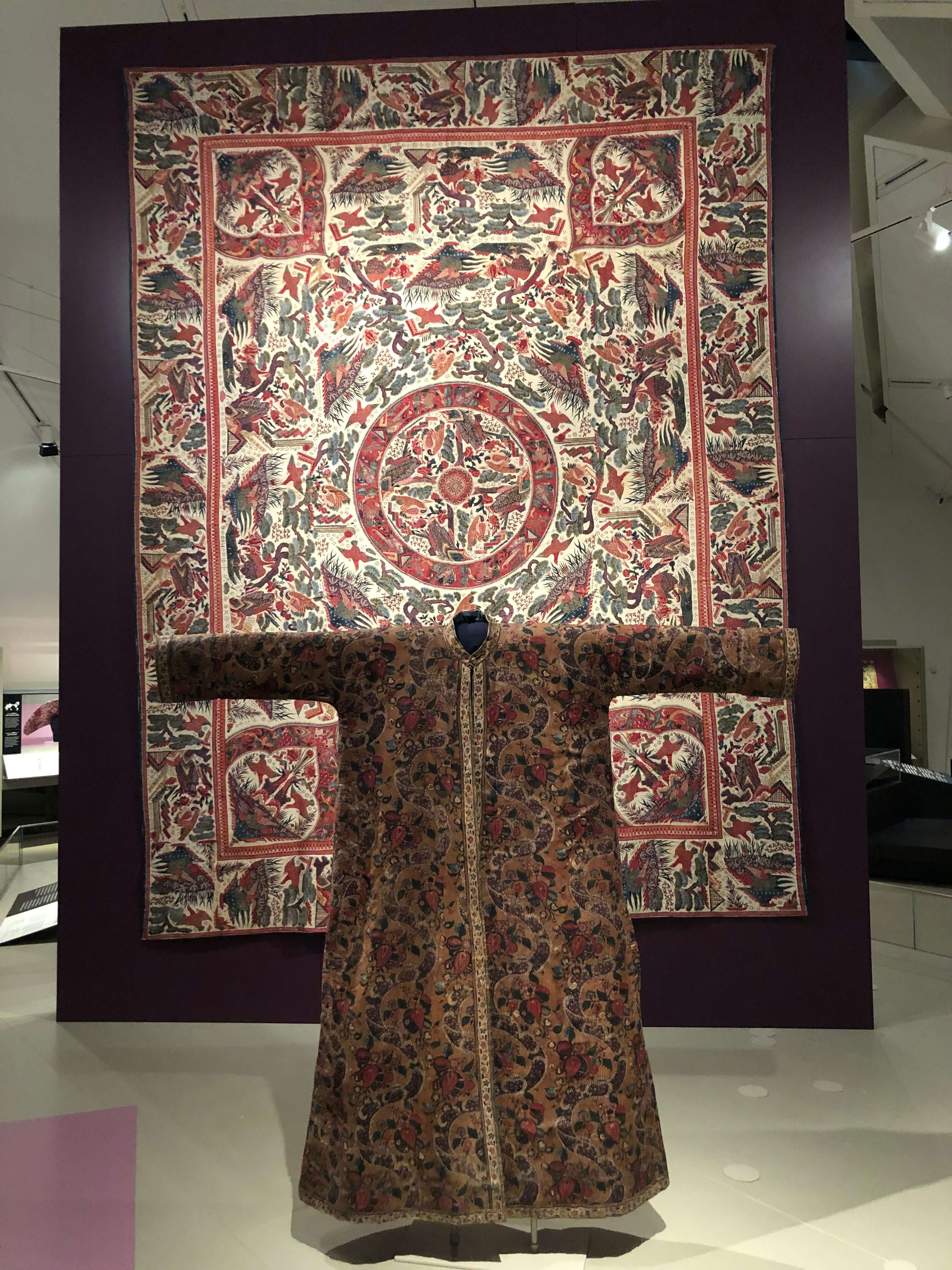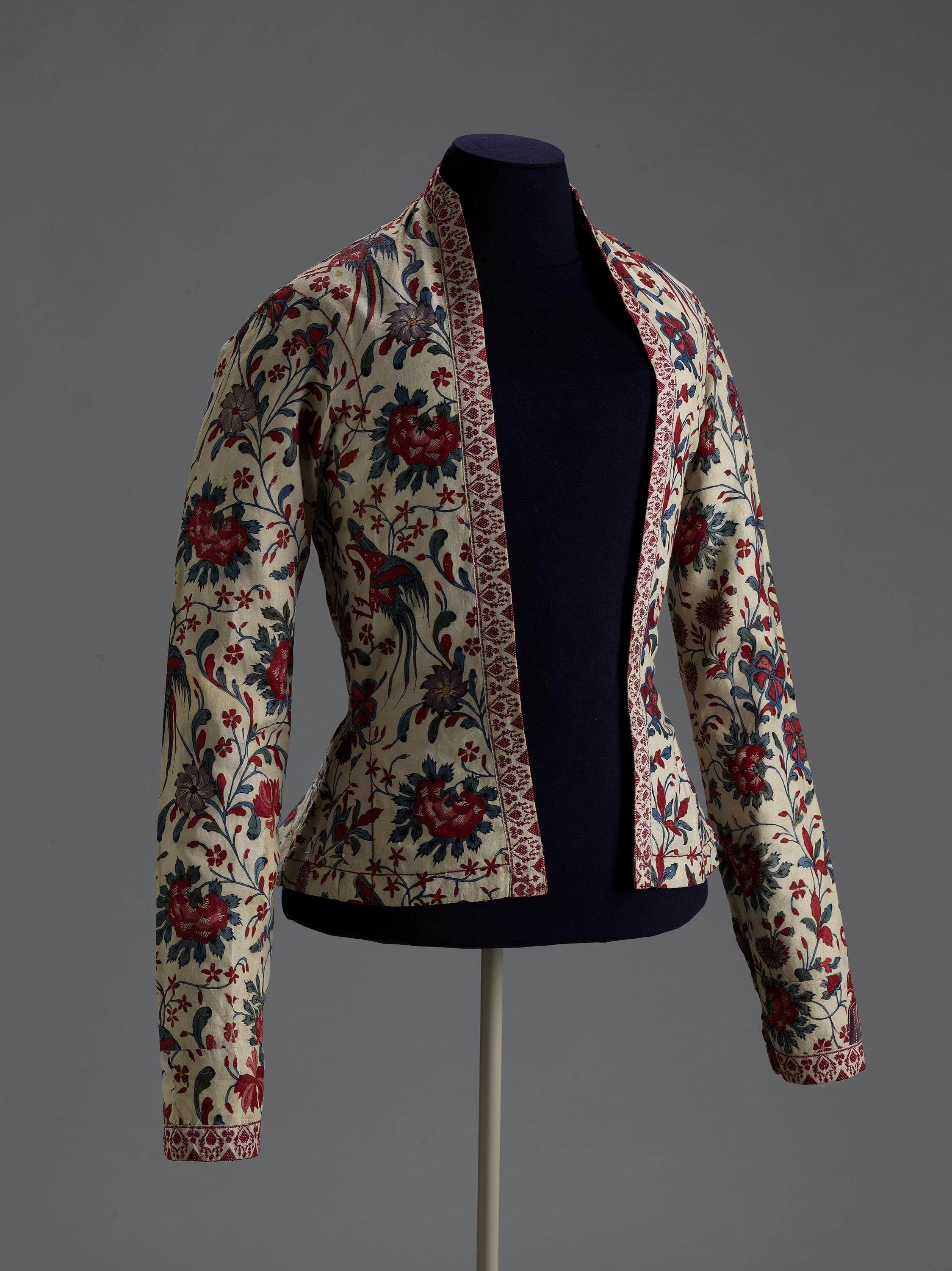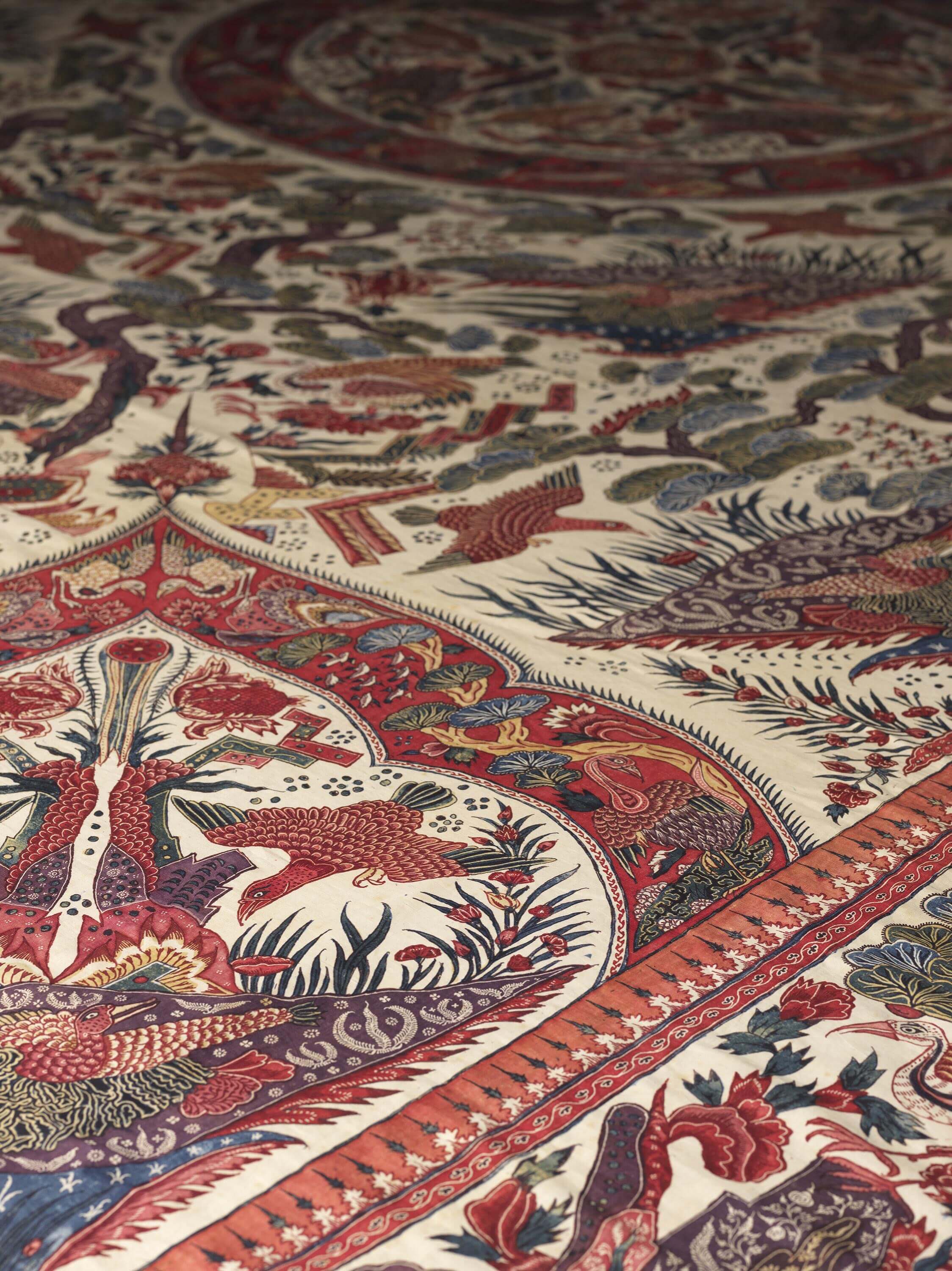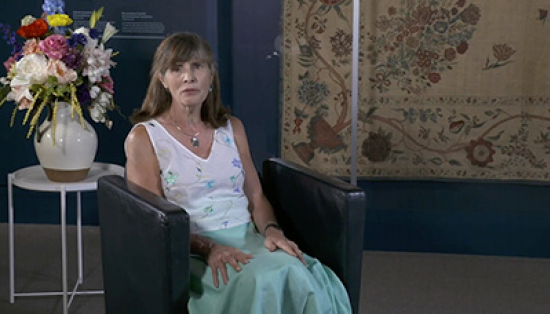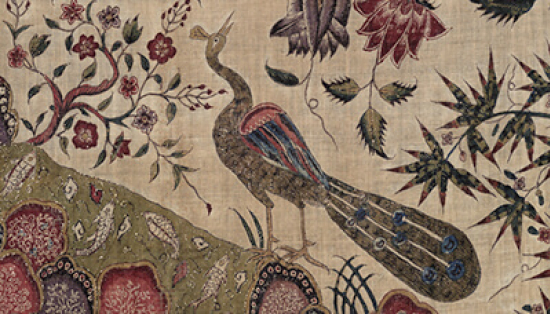Every Thursday at 10 am on Instagram we chat with a different ROM expert ready to answer your burning questions on a different subject. This time on Ask ROM Anything we are talking to Dr. Sarah Fee, the Senior Curator of Global Fashion & Textiles at the ROM. Sarah is the lead curator for the exhibition The Cloth that Changed the World: India’s Painted and Printed Cottons, which takes a new look at the ROM’s celebrated collection of Indian chintz fashions and furnishings.
For this project, Sarah worked with a multi-disciplinary team to consider how this luxury cloth has connected cultures and revolutionized fashion, industry, and global trade for over 1,000 years. This exhibition celebrates Indian artisans unparalleled mastery of design and natural dyes – historically and today – as a new generation of practitioners revive and innovate colour and design for contemporary consumers.
Delving beneath the beautiful surfaces, this exhibition explores the environmental and social costs of the mass production of coloured cottons, then and now.
Q. When might we be able to visit this exhibition?
A. We are thrilled to say the exhibition The Cloth that Changed the World: India’s Painted and Printed Cottons opened to the public on September 12th and runs until September, 6, 2021. This exhibition is included with a general admission ticket (no extra cost).
Q. What are some of the more unique sources of pigment? Have they changed much over time?
A. Our exhibition explores the many sources of dyes used in India to colour cottons! It is actually very difficult to colour cotton with natural dyes. We have samples of the ingredients and films to help our visitors understand the great skills and knowledge required to create coloured pattern.
One reason while all the world desired Indian chintz was because of its bright colours. Some plant sources were native to India: turmeric for yellow, the leaves of indigofera tinctoria for blue, the roots of the chayavar plant for bright red. However, these alone do not provide colour; instead, India’s artisans produced complex chemical formulae by combining these seemingly humble ingredients to bind them permanently to cotton. They used mineral salts – alum and iron (from rusty nails and horsehoes!!) – to create red, black and purple, lime and cassia seeds to control the acidity of indigo dye baths, and used animal dung and sunshine to bleach white fabric grounds and brighten colours. It took much knowledge, and skills handed down over generations, to control all these varied ingredients to get bright and durable shades.
Other plant sources used over time include pomegranate rind – today very popular for yellow – acacia and madder plant roots.
Q. How did people wear heavy fabrics like this in such hot climates?
A. What makes cotton cloth so remarkable and desirable is actually its qualities for wearing in the heat! It is breathable, absorbent, and can be washed easily. Many Indian artisans developed ingenious techniques to produce bright colours and patterns that stood up to repeated washing. This is why in Europe in particular – where it is difficult to grow cotton – India’s colourful cottons became wildly popular from the 1600s. Unlike linen, wool and silk, cotton is easier to wash.
Indian weavers told me that handwoven cotton is especially breathable and cool to wear in high temperatures and I agree and wear handwoven Indian cottons mostly in summer, where even here in Toronto temperatures can climb! Alternatively, cotton that is spun tucker, woven tightly and quilted with cotton padding makes for a warm winter fabric!
Q. What do you see in the future of sustainable fashion?
A. Our exhibition does consider the notion of sustainability in regards to global consumption of printed cottons today... both in terms of industrial cottons and handcrafted cottons from India. Both groups of producers have been working in recent years to conserve water, use eco-friendly dyes, and grow more sustainable varieties of cotton.
The pandemic has changed some aspects of sustainability, in that where the world was turning was away from single use plastics, we are now needing them again. However, cotton fibers and other textile fibers are some of the biggest polluters and sources of microfibers (found today even in remote areas o the oceans and the arctic). If we continue to reduce our purchases of clothing, repair and reuse items we already own, and recycle those we no longer need, we can continue the fight against environmental degradation and climate change.
Q. How did the ROM acquire this collection of Indian fabric?
A. There are four basic channels. In 1934, the widow of British textile designer Harry Wearne donated about 100 pieces he had collected in Europe in the 1910s (the donation also included hundreds of block printed cottons made in Europe). These were mostly painted cottons made in India for export to Europe in the 1700s, but also included some items made in India for export to Iran. Then in the 1950s, ROM curator Katharine Brett (a co-author of the pioneering book Origins of Chintz) acquired chintz fashion items from vendors in Europe, as well as some masterpieces from a collector in the Netherlands. In the 1970s, the ROM obtained a collection of about 25 fragments found in Egypt, donated to the museum in memory of ROM curator Veronika Gervers, who tragically died young. Finally, in the past 15 years, my colleague Alexandra Palmer and I have acquired pieces to fill gaps (notably Indian chintz made for export to Indonesia*); most recently, to bring our collection up the current date, we have acquired fashion and artworks by makers at the forefront of the new wave of Indian chintz: Renuka Reddy, Ajit Kumar Das, M. Kailasham, Pracheen, Abduljabbar Khatri and fashion house 11.11 eleven eleven.
If you would like to learn more on how the pieces came to the ROM, I wrote an essay on this topic for the journal Textiles Asia, September 2019.
Q. How did chintz “change the world”?
A. Indian chintz (i.e. its painted and printed cottons) changed the world in many ways... we look at three main areas, which historians have described in recent decades:
1. Indian cotton cloth, particularly its colourful printed and painted chintz, connected the ancient world. Already by about 30 CE, Indian cottons served as the “backbone” to trade from Indonesia to Rome, in other words, peoples across the Indian Ocean and Mediterranean sea all desired the cloth, and it was traded by land and sea to all the major ancient ports and caravan routes. Indian artisans were masters at creating colours and design to please each niche market. Until about 1750, India’s cotton cloth making was the world’s largest industry and export commodity.
2. Indian chintz has been called the first truly global fashion: after the 1500s, the fashion spread beyond Eurasia, carried by merchants across the Pacific and Atlantic oceans to the Americas and Pacific, where it also became popular with both elites and merchant/working classes. The design and techniques of Indian chintz influenced textile artisans across Africa, Asia and Europe. Scholars link the rise and designs of batik in Java, and tapa barkcloth floral printing in Tahiti, as well as folk dress and fabrics in Provence, France and Genoa, Italy, to imports of Indian chintz.
3. Historians now credit Indian chintz with launching Europe’s “industrial revolution” of the late 1700s: in broad strokes, Europeans sought to imitate Indian chintz in order to cash in on this profitable commodity, which their East India companies by 1650 were shipping in vast quantities from India to Europe. To cut costs and speed production, from 1750 the British in particular mechanized cotton spinning, and created the first industrial machines and factories to spin and print cotton. From 1850, Europeans created synthetic (laboratory) dyes that were faster and cheaper to print than plant-based dyes. While history books in the past celebrated such inventions, today we appreciate that Europe’s industrial rise was less a “revolution” than an “evolution”, as it took over 150 years for Europeans to master India’s printing and dye secretes. So, too, today we recognize the environmental destruction from the mass production of consumption of printed cottons, with its polluting dyes, and harmful microfibers now showing up in remote ocean floors and the Arctic.
Q. Was William Morris influenced by Indian chintz? I see some similarities in his designs!
A. Thank you for this question, and very well spotted! William Morris (British Arts & Crafts artisan and activist, 1834-1896) found design inspiration for his printed textiles from many sources, European and Asian. Linda Parry in her book (William Morris Textiles, London: V&A Publishing, 2013) has traced out many of them. He spent much time at the Victoria & Albert Museum and its India Museum and was partial to Turkish, Iranian, Italian and Indian textiles. Parry identifies the period from 1875-77 when his printed textile patterns appear more directly Indian-inspired – and with warmer colours: Indian Diaper, Little Chintz, and Pomegranate. You can see Indian Diaper from the V&A’s collection here.
Arguably it was not design, but Indian dyes and printing techniques that had the greatest impact on Morris. Rejecting the Victorian era’s industrially printed cloth and the new synthetic dyes, he reached back to the cloth printing techniques of India, which Europe had appropriated in the 1700s: hand carved wooden printing blocks, printing with mordants thickened with gums followed by dyeing with red dye plants. He used many dye plants found in England, but for his blues used the indigo dye vat, a technique perfected in India, whose colour he found far superior to any of the laboratory-produced blues of his day.
Q. Where does the word ‘chintz’ come from, and what does it mean?
A. Many Indian words have entered the English language, showing our many debts to India for so many dress and fashion things: pyjama, khaki, calico, bandana... and also chintz!
The original term was the Hindi “chint” which means simply speckled, or variegated. In the 1600s, the British began to use the term chint to refer to painted and printed cottons from India. They then added an “s” to make it plural: chints. Over time, it became written “chintz”. Into the 1700s, most Indian chintz was a costly luxury in Europe, affordable only to the wealthy.
The term “chintzy” to mean cheap and gaudy appeared much later in the English language, in the 1850s. It is attributed to the author George Eliot (Mary Ann Evans). At that time, Britain’s factories had flooded world markets with cheap industrial imitations of India’s handmade chintz.


